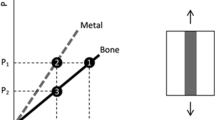Abstract
Titanium and its alloys have many attractive properties including high specific strength, low density, and excellent corrosion resistance. Besides, titanium and the Ti6Al4V alloy have long been recognized as materials with high biocompatibility. These properties have led to the use of these materials in biomedical applications. Despite these advantages, the lack of good wear resistance makes difficult the use of titanium and Ti6Al4V in some biomedical applications, like articulating components of prostheses.
Some surface treatments are available in order to correct these problems, like thermal surface treatment by means of nitrogen gaseous diffusion at high temperature. Nitrogen enters into the material by diffusion, creating a surface layer of increased hardness.
Low cycle fatigue behavior in air of Ti6Al4V alloy has been studied. Results show a reduction of low cycle fatigue life up to 10% compared to the not-treated material. Studies suggest it is not related to the titanium nitride surface layer, but to microstructural changes caused by the high temperature treatment.
© 2001 Kluwer Academic Publishers
Similar content being viewed by others
References
P. H. Morton and T. Bell, in “Proceedings of the 6th World Conference on Titanium” (Cannes, France, 1988) p. 1705.
J. M. Manero, in “Estudio del comportamiento a fatiga oligocíclica de la aleación Ti6A14V tratada térmicamente”, Ph.D. Thesis, Universitat Politècnica de Catalunya, Barcelona (1997).
F. J. Gil, D. RodrÍguez, E SÁnchez, J. M. Manero and J. A. Planell, in “Proceedings of the 5th World Biomaterials Congress” (Toronto, Canada, 1996) 2, p. 477.
G. Welsh, R. Boyer and E. W. Collins, in “Handbook of Material Properties: Titanium alloys” (ASM, USA, 1994).
H. Shibata, K. Tokaji, T. Ogawa and C. Hori, Fatigue 16 (1994) 370.
A. Bloyce, “Wear protection of titanium alloys: Surface performance of titanium”, edited by (ASM-TMS, USA, 1997) p. 155.
D. RodrÍguez, in “Obtención de capas de nitruro de titanio mediante tratamiento termoquímico en titanio y Ti6Al4V y caracterización de sus propiedades para aplicaciones biomédicas”, Ph.D. Thesis, Universitat Politècnica de Catalunya (2000).
Author information
Authors and Affiliations
Rights and permissions
About this article
Cite this article
Rodríguez, D., Manero, J.M., Gil, F.J. et al. Low cycle fatigue behavior of Ti6Al4V thermochemically nitrided for its use in hip prostheses. Journal of Materials Science: Materials in Medicine 12, 935–937 (2001). https://doi.org/10.1023/A:1012892511845
Issue Date:
DOI: https://doi.org/10.1023/A:1012892511845




